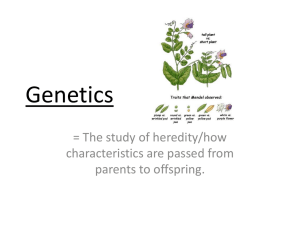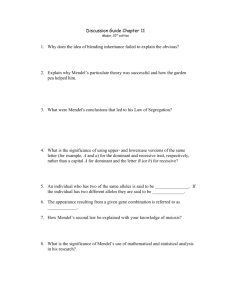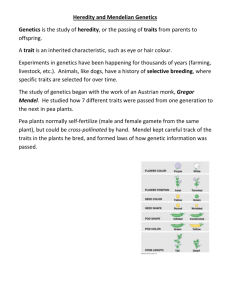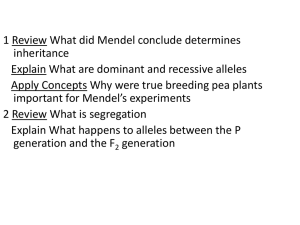Chapter 12
advertisement
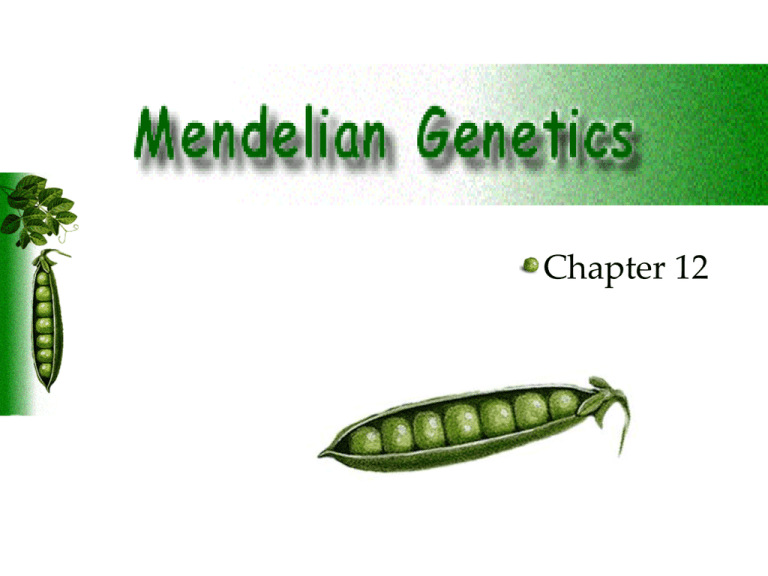
Chapter 12 I. Mendel: The Father of Genetics Genetics: Study of heredity. Heredity: Passing of traits from parents to offspring. Mendel used the garden pea : Has many traits, two clearly different forms; easy to tell apart. Mating can easily be controlled Useful Features of Peas Small, grows easily, matures quickly, and produces lots of offspring. Self-pollinates (easy breeding) Seeds inherit all traits from the plant that bore them! Mendel’s First Experiments In your book, p. 269! Please read about Mendel’s experiment and simplify the steps by explaining them in your own words. (Pair-Share) Mendel studied crosspollination, produces seeds that are the offspring of two different plants. * Mendel began with purebred plants (the result of selfpollination). Hybrids – org. produced by crossing parents with different traits. (ex. Purple flower X white flower) True-Breeding = All offspring displays same form of a trait. P generation = parents. F1 generation = offspring of the p generation. F2 generation = offspring of the F1 generation. In familiar terms please… P generation (grandpa) F1 generation (dad) F2 generation (baby) All F1 plants showed only one form of the trait. (i.e. all offspring had purple flowers) All of the different trait had disappeared!! When the F1 plants self-pollinate, the missing trait reappeared in the F2 generation! Summary Mendel found that for all seven traits that he studied, a 3:1 ratio was observed in the F2 generations. Mendel’s Theory 1.For each inherited trait, an individual has two copies of the gene—one from each parent. 2.There are alternative versions of each gene, called ALLELES. Mendel’s Laws 3. When 2 different alleles occur together, one may be completely expressed, while the other “disappears”. do NOT blend! Dominant: The expressed form of a trait. Recessive: Is not expressed if a dominant allele is present. Important Terms Using the Frayer Model (reading strategy) explain the relationship between the following genetics terms, beginning on p. 273: • Genotype vs. Phenotype •Homozygous vs. Heterozygous •Dominant vs. Recessive Mendel’s Laws 1. Law of Segregation: When an organism produced gametes, each pair of alleles is separated and each gamete has an equal chance or receiving either one of the alleles. Mendel’s Laws 2. Law of Independent Assortment: during gamete formation, alleles for each trait segregate independently. •inheriting one trait doesn’t affect your inheritance of another trait Types of Crosses Monohybrid = involves one trait (Ex. seed color) Dihybrid = involves two traits (Ex. Seed colod and seed shape) Punnett Squares •Model that predicts the likely outcomes of a genetic cross. •Shows all of the genotypes that could result! Pedigrees A pedigree is a family history that shows how a trait is inherited over several generations. Circles = females Squares = males Shaded circle or square = trait expressed. Circle or square not shaded = trait not expressed. Autosomal traits =Located on chromosomes other than X and Y. Will appear in both sexes equally. A sex-linked trait is a trait whose allele is located on the X chromosome. Most sex-linked traits are recessive. Why would a sexlinked disorder show up more in males than in females? Working sex-linked Punnett Squares: A. Blood Groups ABO Red Groups Blood Cells (RBC) can carry two antigens, A & B Presence & absence of A & B antigens produces 4 possible blood types: A, B, AB, O B. Rh Groups + if Rh antigen is present on RBC, - if not. Phenotype Genotype A B AB O IAIA, IA i IBIB, IB i IAIB ii Traits NOT controlled by simple dominant-recessive alleles Ex. Height, weight, hair color, skin color in humans Polygenic traits: Traits controlled by multiple genes. Incomplete Dominance = Offspring displays a trait intermediate between the two parents. Ex. Red + white = pink in snapdragons. Ex. Straight + Curly = wavy hair in Caucasians. Codominance = Two dominant alleles are expressed at the same time. Ex. Red hair + white hair = roan hair in horses & cattle Multiple Alleles = Genes with 3 or more alleles. Ex. ABO blood group Traits Influenced by the Environment Acidity of soil determines flower color in hydrangea Temperature affects coat color of arctic fox. Fur on the ears, nose, paws, and tail is darker in Siamese cats because body temperature is cooler. Traits Caused by Mutation 1. Sickle Cell Anemia = A recessive disorder caused by a mutated allele that produces hemoglobin. RBC take on a disk-like shape when oxygen levels are low. Results in poor blood circulation. 1:500 African Americans Protects affected people from malaria. 2. Hemophilia Recessive Sex-linked Impairs blood’s ability to clot. 1:10,000 white males 3. Huntington’s Disease Caused by a dominant allele on an autosome. Symptoms begin to show in 30’s or 40’s. Forgetfulness and irritability, loss of muscle control, eventually death. Was brought to US by two brothers from England in 1600’s, who fled allegations of witchcraft. The “strange” behaviors was actually caused by the onset of this disease. 4. Cystic Fibrosis Recessive autosomal Mucus clogs organs, including lungs and liver 1:2,500 whites 5. Tay-Sachs Disease Recessive Deterioration of central nervous system in infants Caused by a defective form of a brain enzyme. 1:3,500 Ashkenazi Jews 6. PKU PKU babies lack an enzyme that converts phenylalanine into the amino acid tyrosine. As a result, phenylalanine build up in the body, causing mental retardation. Early detection and a special diet can prevent mental retardation.

